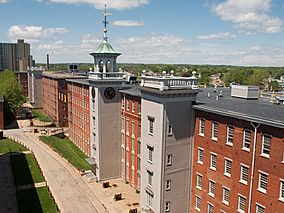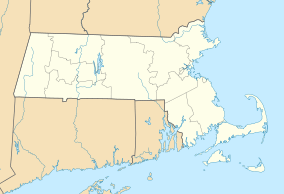Lowell National Historical Park facts for kids
Quick facts for kids Lowell National Historical Park |
|
|---|---|

The Boott Cotton Mill & Museum
|
|
| Location | Lowell, Massachusetts, United States |
| Nearest city | Lowell, Massachusetts |
| Area | 141 acres (57 ha) |
| Established | June 5, 1978 |
| Visitors | 520,452 (in 2011) |
| Governing body | National Park Service |
| Website | Lowell National Historical Park |
Lowell National Historical Park is a special place in Lowell, Massachusetts, where you can explore the exciting history of America's Industrial Revolution. It's like a big outdoor museum, run by the National Park Service, that shows how Lowell became a major center for making cloth in the late 1700s and early 1800s. The park was created in 1978 to protect these important historical sites. In 2019, Lowell National Historical Park was even featured on a special America the Beautiful Quarters coin!
Contents
Lowell's Industrial Story
How Lowell Became a Mill City
In the early 1820s, a place called East Chelmsford (which later became Lowell) was perfect for building factories. It was located along the Merrimack River and had powerful waterfalls called the Pawtucket Falls. These falls could provide lots of energy to run machines.
Engineers built a system of canals, like the Middlesex Canal, to connect the Merrimack River to Boston. This made it easy to transport goods. Unlike many other factory towns, Lowell was carefully planned. People wanted to create a city where factories were efficient but also had good living conditions for workers. They called it the "Lowell Experiment."
The Lowell Experiment: A New Kind of City
The people who planned Lowell wanted it to be different from crowded factory towns in Great Britain. They designed the city with green spaces and clean dormitories for workers. This was a new idea for its time!
Many people came to Lowell to work in the mills. These included immigrants from other countries and people from other parts of New England and Quebec. A large number of young women, known as the Lowell mill girls, also came to live in the dorms and work in the factories.
Saving Lowell's History
After World War II, the textile industry in New England started to decline. By the 1960s, many of Lowell's factory buildings were empty. But some people realized how important Lowell's history was.
In the late 1960s and early 1970s, several groups worked together to save these historic sites. Important leaders like United States Senator Paul Tsongas helped make it happen. In 1978, the United States Congress officially created the Lowell National Historical Park. This park helps preserve the history of the Industrial Revolution and share it with everyone.
Exploring Lowell National Historical Park
The park has many interesting places to visit. You can learn about how factories worked and what life was like for the people who lived and worked there.
What You Can See and Do
- Boott Cotton Mill and Museum: This is one of the oldest and most completely restored factory sites. You can walk through the museum and see how textile machines worked in the 1800s.
- The Lowell Canal System: Explore the canals that powered the mills. You can even take boat tours!
- Mill Girls and Immigrants Boardinghouse: See where the factory workers lived. This helps you understand their daily lives.
- Pawtucket Dam and Gatehouse: Learn how water was controlled to power the factories.
- National Streetcar Museum: Ride a historic trolley through the park.
- Boarding House Park: This park hosts fun events like the Lowell Folk Festival and the Lowell Summer Music Series.
Visitor Center and Tours
The park has a visitor center where you can start your adventure. It offers free tours and exhibits that tell the story of Lowell. You can see cool displays, like a model of a loom (a machine for weaving cloth) invented by S. Thomas.
There's also a walking path along the Merrimack Canal. Plaques along the path explain the history of different sites. You can even take a detour to a memorial for the famous author Jack Kerouac, who wrote about Lowell.
The Patrick J Mogan Cultural Center focuses on the lives of the many different immigrant groups who came to Lowell over the years. You can also see the River Transformed / Suffolk Mill Turbine Exhibit, which shows how water power and the Francis Turbine made Lowell's factories run.
Images for kids
-
U.S. President Jimmy Carter (center) with Ted Kennedy (left) and Paul Tsongas signs the creation of Lowell National Historical Park, 1978
See also










